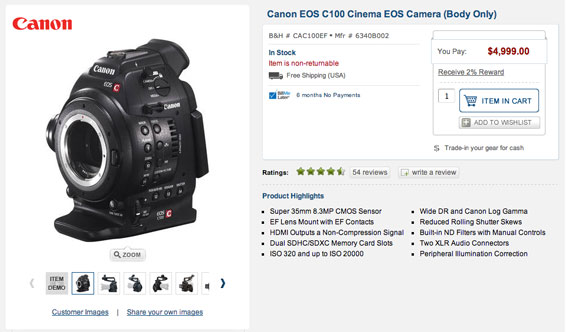Why Use A C100 If You Have A C300?
I try to practice what I preach. Use the right tool for the job. It’s saves me the headache of trying to get the camera to work for me. When I’m shooting I just want the camera to get out of the way so I can focus only on shooting and capturing audio.
When our producer explained to me the concept for these two shoots on cyberbullying I knew I wanted to use the Canon C100 for one of the spots. The version with the teen girl was pretty much a handled shoot except for the scene in her bedroom. I used a Kessler CineSlider.
I like the Manfrotto FigRig a lot for handheld. I’m comfortable using it. Even though the Canon Cinema EOS cameras have pretty good ergonomics if your shooting for long periods handheld it gets tiring. Holding the camera in front of you isn’t the most natural position after 5 hours. Add in a shoulder issue I’ve been having that makes me want to make the camera as light as possible.
So why use the C100 instead of the C300? The C100 is lighter and a little smaller making it easier for me to shoot handheld for longer periods of time. I also didn’t need the larger LCD screen that the C300 has since I was using a SmallHD DP6 that the director was holding and making sure he liked the shots. I had him bring it close to me for pre-focusing. The LCD on the back of the C100 was good enough for framing and the punch in feature works really well just to make sure i’m all good. Below is both Cyberbullying spots. The first one was shot with the C300 also in C Log.
I’m comfortable with using the AVCHD codec as well. For this shoot I went with the internal codec and C Log. I could have added a Atomos Ninja 2 but then the weight would make this” keeping it lighter” idea not work very well. We knew the grade wasn’t going to be very intense and the codec edits just fine for color correction and light grading.
I set the camera up with C Log gamma and shot 24P with the shutter set at 180 degree shutter angle. The main lens was the Canon 24-105 with it’s great image stabilization. Lifesaver! Sharp and stable in the FigRig.
I had used a Lectrosonics SRB Dual Channel wireless receiver for the audio in the kitchen but that scene was pretty easy to shoot since they where short shots at different angles. The Lectrosonics SRB Dual Channel is a very good wireless system. Eats batteries like a starving football player but the audio quality is very good. Having two channels on one receiver is huge when your using small cameras with limited mounting options. It’s expensive but worth it.
Lighting was mainly two Kino Flo Divas and a ARRI 650 kit. I used a large 2 stop fabric on a c-stand and arm to light the kitchen and hall way, but not over light it. I wanted it to fell a little depressing and some what warmer. I do fell I needed a little more punch but hey we live and learn for the next one right? In the bed room we had one Kino Flo dimmed down a lot. I had to put a CTO filter in the lamp because it was casting a greenish color. Strange bulb in that lamp!
In post the spot graded just fine and nobody new the difference between the two cameras. Everyone was happy and my shoulder was too. Never let you’re gear get in your way. Do whatever it takes to get the best out of yourself and don’t worry. If the technique is good and the script is solid nobody cares what camera you used.
Thanks for coming by! Please help support my site by using the links on this page or bookmark these from my favorite retailers, B&H, Adorama, Zacuto, Amazon.com & Think Tank Photo. Using the links cost you nothing extra, but it helps offset the cost of running my blog. Thanks again for coming by eriknaso.com!
Filed in: C100 • C300 • Canon • Canon Cinema EOS • Featured Post • Lighting • Post Production • Production















Hi Eric,
Great post! Thanks for sharing the behind the scenes as well. Looks like it was a good shoot overall. Curios if you had thought to shoot with the C100 and a Ninja 2 instead of the DP6. You would still get the benefit of the C100’s smaller size but also having the higher quality file to work with. I don’t think the C100 spot suffers at all from the codec, but was just curious on your thoughts.
I found the DP screens better than the Ninja’s for monitoring, but like having that higher bit rate file to color grade with if necessary.
I actually did think about using the Ninja 2 but chose to go as light as possible, and adding the external recorded didn’t make sense. I have had enough experience grading the AVCHD footage so I knew it would be fine. You have to trust your gear!
Thanks for visiting the blog!
Erik
I’ve found that if you use c-log and expose as close to perfect as possible in camera, then there’s quite a bit of flexibility for color grading in post with the internal codec. I’d love to see the difference the Atomos Ninja makes, though.
You are right on the mark! Expose correct and you have so much to work with. I under exposed a few shots before and really paid for it. The image got really noisy and I had to clean it up, but still was usable. Love that! I did a shoot with some Canon CN=E primes and used the Ninja 2. I looked at the AVCHD version since I double recorded and really didn’t see a difference. I should do a post on that. Here is the piece and the lens review.
C100 and Ninja 2
Canon CN-E Review.
https://eriknaso.com/2013/07/16/canon-cn-e-cinema-primes-hands-on-review/
Thanks for links! Beautiful footage! It’s scary to think that one of those Cine primes costs as much as my C100.. Rokinons are more within my budget.
Thank you for a great post.. would like to see some real world examples of to expose C-Log properly for best results. There is some useful information out there but its always good to see it backed up by practical examples. Is it ultimately down to trusting what you see on the waveform? Thanks again from the UK.
Hi Glenn.
Check out this post. I think it covers a lot about shooting and grading C Log.
https://eriknaso.com/2013/04/25/shooting-and-editing-canon-log-with-the-c300-and-c100/
Cheers Eric! I’ve been through this post and studied the Colorista tutorials which have been really helpful. I’m open to more information on the decisions that are made exposing the image in-camera to begin with. The conventional knowledge says underexpose and dont clip at all costs… I’m interested in seeing how fine a line you have when making these choices. Thanks again and keep up the great work 🙂
Hi Erik, thanks for all you do to support this community. I really enjoy your posts, Tweets, discussions on DVXuser, etc. I found this post as part of my research into a new camera. I have it narrowed down to the C100 mkii or the GH5 w/Metabones and probably Canon glass. I currently have a GH4/Metabones/Nikon. I’m not opposed to migrating to all native MFT lenses, either, since the GH5 has less crop. I’d appreciate your thoughts on whether a C100 would even be worth it, as it’s someone “old.” Everything I deliver is 1080p – never 4K. I like being able to crop 4K in post, minor pans/zooms. But I often feel like it makes me lazy in framing my shots. Slow motion is cool, but I think 60p gives you enough of that effect. Then again, I’ve never shot 180fps so I can’t really say how much I’d use it. Anyway, this post speaks to me in that the C100 just gets out of the way and lets you shoot. Do you feel the same way about the GH5? With the XLR attachment, cage, etc I could rig it well. I watched your “how to choose a camera” on Lynda, but I’m having trouble deciding. I’d love the C200 but it’s out of my budget 🙂